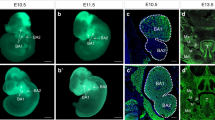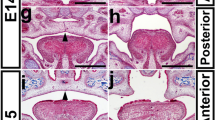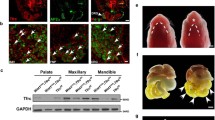Abstract
Bone morphogenetic protein (BMP) signaling plays a crucial role in the development of craniofacial organs. Mutations in numerous members of the BMP signaling pathway lead to several severe human syndromes, including Pierre Robin sequence (PRS) caused by heterozygous loss of BMP2. In this study, we generate mice carrying Bmp2-specific deletion in cranial neural crest cells using floxed Bmp2 and Wnt1-Cre alleles to mimic PRS in humans. Mutant mice exhibit severe PRS with a significantly reduced size of craniofacial bones, cleft palate, malformed tongue and micrognathia. Palate clefting is caused by the undescended tongue that prevents palatal shelf elevation. However, the tongue in Wnt1-Cre;Bmp2f/f mice does not exhibit altered rates of cell proliferation and apoptosis, suggesting contribution of extrinsic defects to the failure of tongue descent. Further studies revealed obvious reduction in cell proliferation and differentiation of osteogenic progenitors in the mandible of the mutants, attributing to the micrognathia phenotype. Our study illustrates the pathogenesis of PRS caused by Bmp2 mutation, highlights the crucial role of BMP2 in the development of craniofacial bones and emphasizes precise coordination in the morphogenesis of palate, tongue and mandible during embryonic development.








Similar content being viewed by others
References
Alappat SR, Zhang Z, Suzuki K, Zhang X, Liu H, Jiang R, Yamada G, Chen Y (2005) The cellular and molecular etiology of the cleft secondary palate in Fgf10 mutant mice. Dev Biol 277:102–113
Baek JA, Lan Y, Liu H, Maltby KM, Mishina Y, Jiang R (2011) Bmpr1a signaling plays critical roles in palatal shelf growth and palatal bone formation. Dev Biol 350:520–531
Barrow JR, Capecchi MR (1999) Compensatory defects associated with mutations in Hoxa1 restore normal palatogenesis to Hoxa2 mutants. Development 126:5011–5026
Bjork BC, Turbe-Doan A, Prysak M, Herron BJ, Beier DR (2010) Prdm16 is required for normal palatogenesis in mice. Hum Mol Genet 19:774–789
Bonilla-Claudio M, Wang J, Bai Y, Klysik E, Selever J, Martin JF (2012) Bmp signaling regulates a dose-dependent transcriptional program to control facial skeletal development. Development 139:709–719
Brinkley LL, Vickerman MM (1978) The mechanical role of the cranial base in palatal shelf movement: an experimental re-examination. J Embryol Exp Morphol 48:93–100
Casey LM, Lan Y, Cho ES, Maltby KM, Gridley T, Jiang R (2006) Jag2-Notch1 signaling regulates oral epithelial differentiation and palate development. Dev Dyn 235:1830–1844
Chai Y, Maxson RE Jr (2006) Recent advances in craniofacial morphogenesis. Dev Dyn 235:2353–2375
Chai Y, Bringas P Jr, Shuler C, Devaney E, Grosschedl R, Slavkin HC (1998) A mouse mandibular culture model permits the study of neural crest cell migration and tooth development. Int J Dev Biol 42:87–94
Chai Y, Jiang X, Ito Y, Bringas P, Han J, Rowitch DH, Soriano P, McMahon AP, Sucov HM (2000) Fate of the mammalian cranial neural crest during tooth and mandibular morphogenesis. Development 127:1671–1679
Chen G, Deng C, Li Y-P (2012) TGF-β and BMP signaling in osteoblast differentiation and bone formation. Int J Biol Sci 8:272–288
Choi KY, Kim HJ, Lee MH, Kwon TG, Nah HD, Furuichi T, Komori T, Nam SH, Kim YJ, Kim HJ, Ryoo HM (2005) Runx2 regulates FGF2-induced Bmp2 expression during cranial bone development. Dev Dyn 233:115–121
Danielian PS, Muccino D, Rowitch DH, Michael SK, McMahon AP (1998) Modification of gene activity in mouse embryos in utero by a tamoxifen-inducible form of Cre recombinase. Curr Biol 8:1323–1326
Ducy P, Karsenty G (2000) The family of bone morphogenetic proteins. Kidney Int 57:2207–2214
Ferguson MWJ (1977) The mechanism of palatal shelf elevation and the pathogenesis of cleft palate. Virchows Arch A Pathol Anat Histol 375:97–113
Ferguson MWJ (1988) Palate development. Development 103:41
Fukuda T, Scott G, Komatsu Y, Araya R, Kawano M, Ray MK, Yamada M, Mishina Y (2006) Generation of a mouse with conditionally activated signaling through the BMP receptor, ALK2. Genesis 44:159–167
Greenblatt MB, Shim JH, Zou W, Sitara D, Schweitzer M, Hu D, Lotinun S, Sano Y, Baron R, Park JM, Arthur S, Xie M, Schneider MD, Zhai B, Gygi S, Davis R, Glimcher LH (2010) The p38 MAPK pathway is essential for skeletogenesis and bone homeostasis in mice. J Clin Invest 120:2457–2473
Harada Y, Ishizeki K (1998) Evidence for transformation of chondrocytes and site-specific resorption during the degradation of Meckel’s cartilage. Anat Embryol (Berl) 197:439–450
He F, Xiong W, Yu X, Espinoza-Lewis R, Liu C, Gu S, Nishita M, Suzuki K, Yamada G, Minami Y, Chen Y (2008) Wnt5a regulates directional cell migration and cell proliferation via Ror2-mediated noncanonical pathway in mammalian palate development. Development 135:3871–3879
He F, Popkie AP, Xiong W, Li L, Wang Y, Phiel CJ, Chen Y (2010a) Gsk3β is required in the epithelium for palatal elevation in mice. Dev Dyn 239:3235–3246
He F, Xiong W, Wang Y, Matsui M, Yu X, Chai Y, Klingensmith J, Chen Y (2010b) Modulation of BMP signaling by Noggin is required for the maintenance of palatal epithelial integrity during palatogenesis. Dev Biol 347:109–121
He F, Xiong W, Wang Y, Li L, Liu C, Yamagami T, Taketo MM, Zhou C, Chen Y (2011) Epithelial Wnt/beta-catenin signaling regulates palatal shelf fusion through regulation of Tgfbeta3 expression. Dev Biol 350:511–519
Hilliard SA, Yu L, Gu S, Zhang Z, Chen YP (2005) Regional regulation of palatal growth and patterning along the anterior–posterior axis in mice. J Anat 207:655–667
Hoffmann A, Preobrazhenska O, Wodarczyk C, Medler Y, Winkel A, Shahab S, Huylebroeck D, Gross G, Verschueren K (2005) Transforming growth factor-beta-activated kinase-1 (TAK1), a MAP3K, interacts with Smad proteins and interferes with osteogenesis in murine mesenchymal progenitors. J Biol Chem 280:27271–27283
Huang X, Goudy SL, Ketova T, Litingtung Y, Chiang C (2008) Gli3-deficient mice exhibit cleft palate associated with abnormal tongue development. Dev Dyn 237:3079–3087
Jung HS, Oropeza V, Thesleff I (1999) Shh, Bmp-2, Bmp-4 and Fgf-8 are associated with initiation and patterning of mouse tongue papillae. Mech Dev 81:179–182
Kim JY, Cho SW, Lee MJ, Hwang HJ, Lee JM, Lee SI, Muramatsu T, Shimono M, Jung HS (2005) Inhibition of connexin 43 alters Shh and Bmp-2 expression patterns in embryonic mouse tongue. Cell Tissue Res 320:409–415
Koillinen H, Lahermo P, Rautio J, Hukki J, Peyrard-Janvid M, Kere J (2005) A genome-wide scan of non-syndromic cleft palate only (CPO) in Finnish multiplex families. J Med Genet 42:177–184
Lan Y, Ovitt CE, Cho ES, Maltby KM, Wang Q, Jiang R (2004) Odd-skipped related 2 (Osr2) encodes a key intrinsic regulator of secondary palate growth and morphogenesis. Development 131:3207–3216
Lan Y, Zhang N, Liu H, Xu J, Jiang R (2016) Golgb1 regulates protein glycosylation and is crucial for mammalian palate development. Development 143:2344–2355
Ma L, Martin JF (2005) Generation of a Bmp2 conditional null allele. Genesis 42:203–206
Matsumura K, Taketomi T, Yoshizaki K, Arai S, Sanui T, Yoshiga D, Yoshimura A, Nakamura S (2011) Sprouty2 controls proliferation of palate mesenchymal cells via fibroblast growth factor signaling. Biochem Biophys Res Commun 404:1076–1082
Melkoniemi M, Koillinen H, Mannikko M, Warman ML, Pihlajamaa T, Kaariainen H, Rautio J, Hukki J, Stofko JA, Cisneros GJ, Krakow D, Cohn DH, Kere J, Ala-Kokko L (2003) Collagen XI sequence variations in nonsyndromic cleft palate, Robin sequence and micrognathia. Eur J Hum Genet 11:265–270
Muzumdar MD, Tasic B, Miyamichi K, Li L, Luo L (2007) A global double-fluorescent Cre reporter mouse. Genesis 45:593–605
Parada C, Han D, Grimaldi A, Sarrion P, Park SS, Pelikan R, Sanchez-Lara PA, Chai Y (2015) Disruption of the ERK/MAPK pathway in neural crest cells as a potential cause of Pierre Robin sequence. Development 142:3734–3745
Ramaesh T, Bard JB (2003) The growth and morphogenesis of the early mouse mandible: a quantitative analysis. J Anat 203:213–222
Rangeeth BN, Moses J, Reddy NV (2011) Pierre robin sequence and the pediatric dentist. Contemp Clin Dent 2:222–225
Reddi AH (1997) Bone morphogenetic proteins: an unconventional approach to isolation of first mammalian morphogens. Cytokine Growth Factor Rev 8:11–20
Retting K, Song B, Yoon B, Lyons K (2009) BMP canonical Smad signaling through Smad1 and Smad5 is required for endochondral bone formation. Development 136:1093–1104
Rice R, Spencer-Dene B, Connor EC, Gritli-Linde A, McMahon AP, Dickson C, Thesleff I, Rice DP (2004) Disruption of Fgf10/Fgfr2b-coordinated epithelial-mesenchymal interactions causes cleft palate. J Clin Invest 113:1692–1700
Sahoo T, Theisen A, Sanchez-Lara PA, Marble M, Schweitzer DN, Torchia BS, Lamb AN, Bejjani BA, Shaffer LG, Lacassie Y (2011) Microdeletion 20p12.3 involving BMP2 contributes to syndromic forms of cleft palate. Am J Med Genet A 155A:1646–1653
Shu B, Zhang M, Xie R, Wang M, Jin H, Hou W, Tang D, Harris SE, Mishina Y, O’Keefe RJ, Hilton MJ, Wang Y, Chen D (2011) BMP2, but not BMP4, is crucial for chondrocyte proliferation and maturation during endochondral bone development. J Cell Sci 124:3428–3440
Song Z, Liu C, Iwata J, Gu S, Suzuki A, Sun C, He W, Shu R, Li L, Chai Y, Chen Y (2013) Mice with Tak1 deficiency in neural crest lineage exhibit cleft palate associated with abnormal tongue development. J Biol Chem 288:10440–10450
St Amand TR, Zhang Y, Semina EV, Zhao X, Hu Y, Nguyen L, Murray JC, Chen Y (2000) Antagonistic signals between BMP4 and FGF8 define the expression of Pitx1 and Pitx2 in mouse tooth-forming anlage. Dev Biol 217:323–332
Tan TY, Kilpatrick N, Farlie PG (2013) Developmental and genetic perspectives on Pierre Robin sequence. Am J Med Genet C Semin Med Genet 163C:295–305
Tsuji K, Bandyopadhyay A, Harfe BD, Cox K, Kakar S, Gerstenfeld L, Einhorn T, Tabin CJ, Rosen V (2006) BMP2 activity, although dispensable for bone formation, is required for the initiation of fracture healing. Nat Genet 38:1424–1429
Tsuji K, Cox K, Bandyopadhyay A, Harfe BD, Tabin CJ, Rosen V (2008) BMP4 is dispensable for skeletogenesis and fracture-healing in the limb. J Bone Joint Surg Am 90(Suppl 1):14–18
Wang M, Jin H, Tang D, Huang S, Zuscik MJ, Chen D (2011) Smad1 plays an essential role in bone development and postnatal bone formation. Osteoarthr Cartil 19:751–762
Wang Y, Zheng Y, Chen D, Chen Y (2013) Enhanced BMP signaling prevents degeneration and leads to endochondral ossification of Meckel’s cartilage in mice. Dev Biol 381:301–311
Xiong W, He F, Morikawa Y, Yu X, Zhang Z, Lan Y, Jiang R, Cserjesi P, Chen Y (2009) Hand2 is required in the epithelium for palatogenesis in mice. Dev Biol 330:131–141
Xu X, Han J, Ito Y, Bringas P Jr, Deng C, Chai Y (2008) Ectodermal Smad4 and p38 MAPK are functionally redundant in mediating TGF-beta/BMP signaling during tooth and palate development. Dev Cell 15:322–329
Yang W, Guo D, Harris MA, Cui Y, Gluhak-Heinrich J, Wu J, Chen XD, Skinner C, Nyman JS, Edwards JR, Mundy GR, Lichtler A, Kream BE, Rowe DW, Kalajzic I, David V, Quarles DL, Villareal D, Scott G, Ray M, Liu S, Martin JF, Mishina Y, Harris SE (2013) Bmp2 in osteoblasts of periosteum and trabecular bone links bone formation to vascularization and mesenchymal stem cells. J Cell Sci 126:4085–4098
Zhang Y, Zhao X, Hu Y, St Amand T, Zhang M, Ramamurthy R, Qiu M, Chen Y (1999) Msx1 is required for the induction of patched by sonic hedgehog in the mammalian tooth germ. Dev Dyn 215:45–53
Zhang Z, Song Y, Zhao X, Zhang X, Fermin C, Chen Y (2002) Rescue of cleft palate in Msx1-deficient mice by transgenic Bmp4 reveals a network of BMP and Shh signaling in the regulation of mammalian palatogenesis. Development 129:4135–4146
Funding
This study was supported by grant from the National Natural Science Foundation of China (81870739), and by NIH grant (DE026482) to YPC.
Author information
Authors and Affiliations
Corresponding author
Ethics declarations
Animals and procedures used in this study were approved by the Fujian Normal University Institutional Animal Care and Use Committee.
Conflict of interest
The authors declare that they have no conflict of interest.
Electronic supplementary material
Figure S1.
The expression ofBmp2is significantly reduced in the palate, mandibular bone and Meckel’s cartilage of mutant mice. (a-c) Bmp2 is expressed in the anterior palatal (a) as well as in the nasal side palatal mesenchyme and the medial edge epithelium (MEE) region in the posterior palate (b) and Bmp2 is also detected in mandibular bone and Meckel’s cartilage in wild type controls at E13.5 (c). (d-f) In Wnt1-Cre;Bmp2f/f mice, the expression of Bmp2 is significantly reduced in the palate (d, e), mandibular bone and Meckel’s cartilage at E13.5 (f). Mb: mandibular bone; M: Meckel’s cartilage. Scale bars: 100 μm (PNG 2724 kb)
Figure S2.
Expression of genes crucial to palate development in the wild type andWnt1-Cre;Bmp2f/fmice at E13.5. (a-d) Section in situ of Bmp7and Bmp4. Bmp7 is expressed in both the epithelium and mesenchyme in the anterior palatal shelves but only in the epithelium of the posterior palatal shelves. Bmp4 is expressed in the anterior palatal mesenchyme underlying MEE in both control and mutant (e, f). Whole mount in situ of Shh shows that the number and localization of rugae in the E13.5 mutant is comparable to wide type controls (g, h). Msx1 immunostaining(red) of wide type control (i) and mutant palate (j). Msx1 is detected in the anterior palatal mesenchyme of wide type and mutant embryos. Scale bars: 100 μm (a-f, i, j), 500 μm (g, h). (PNG 5202 kb)
Figure S3.
Signal transduction effectors of BMP signaling in the developing palate. (a-d) At E13.5, pSmad1/5/8 are detected in both the anterior and posterior palatal shelves in the wild type and mutant. In the posterior palatal shelves of wild type, pSmad1/5/8 activity is mainly restricted in the mesenchyme of the future nasal side (c) but the pSmad1/5/8 signals become weakened in the mutant embryo (d). (e, g) In wild type control, the pp38 signal is at a high level in the epithelium but is sparse in the mesenchyme in the anterior palate (e); in the posterior palate, pp38 activity is detected in the epithelium and in the oral side palatal mesenchyme (g). (f, h) In the mutant palate, a comparable level of pp38 expression is found. The straight white line in c and d and the straight black line in g and h divides the palatal shelves into nasal and oral halves. Mb: Mandibular bone; M: Meckel’s cartilage. Scale bars: 100 μm. (PNG 2694 kb)
Figure S4.
Myogenic differentiation is unaffected in Wnt1-Cre;Bmp2f/f tongues. (a-d) MF20 immunostaining of coronal sections of control and Wnt1-Cre;Bmp2f/f tongues at E13.5 and E14.5. Arrows point to the extrinsic muscles of the tongue, arrowheads point to the intrinsic muscles. Scale bars: 100 μm (PNG 2383 kb)
Rights and permissions
About this article
Cite this article
Chen, Y., Wang, Z., Chen, Y. et al. Conditional deletion of Bmp2 in cranial neural crest cells recapitulates Pierre Robin sequence in mice. Cell Tissue Res 376, 199–210 (2019). https://doi.org/10.1007/s00441-018-2944-5
Received:
Accepted:
Published:
Issue Date:
DOI: https://doi.org/10.1007/s00441-018-2944-5




